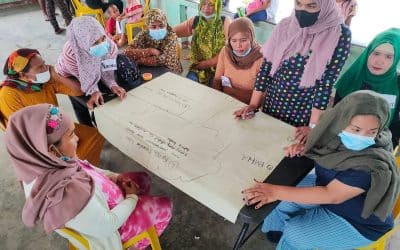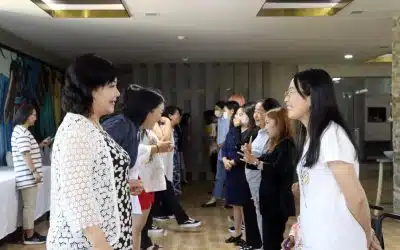InAsia
Insights and Analysis
In India’s Cities, Women Should Work, Thrive, and Loiter
January 16, 2019
They say that India lives in its villages, but this is changing. In 30 years, some 60 percent of India’s population will live in cities. Larger metros such as New Delhi or Mumbai are already grappling with the challenges presented by the constant influx of rural migrants. These megacities are growing rapidly, while their governments are playing catch-up. Access to civic amenities, services, and safe and efficient public transportation is still difficult to come by. This gap affects women even more than men.
India’s smaller cities and towns are growing too; but standing at an earlier stage of their development, they still have the flexibility to plan for growth that is inclusive of women and sensitive to their needs. The Asia Foundation has been promoting women’s security, particularly in urban spaces, for several years. With support from the Korea International Cooperation Agency (KOICA), we have expanded our focus to include India’s smaller cities and towns, which also have fairly poor indicators when it comes to women’s safety. Based on our observations in the Indian cities of Bhopal, Gwalior, and Jodhpur, there are three principal factors that contribute to these unsafe circumstances.
First, women are largely invisible in India’s cities. When seen in public, women walk with purpose, and seldom, as sociologist and researcher Shilpa Phadke puts it, do they loiter. They tend to avoid spending time in public spaces without a specific reason to be there, and they certainly do not do so alone. Working-class women have little occasion for recreation, and using public spaces for such purposes remains a largely foreign concept. To end this public invisibility, women need to claim public spaces as their own.
Second, society incorrectly assumes that a woman’s safety is only a woman’s problem, and most narratives place the onus of women’s security on the individual. If it’s unsafe to meet friends at night, she should stay home. If attacked in a poorly lit street, she should learn martial arts to defend herself. If she is sexually harassed on a crowded bus, she should use a safety pin or a hair clip to poke the offender to teach him a lesson. If she is harassed on the street while walking, she should choose more conservative clothing next time. Stories from the field indicate that routine harassment often forces women and their families to restrict their public movements to identified “safe zones.” This kind of self-policing is indicative that women are not as safe in public spaces as they should be.
Third, the state has failed to provide the public infrastructure necessary to ensure that women can move freely without fear. In Gwalior, for example, safe and high-quality public transportation is absent. Far more than men, who have easier access to private vehicles, this excludes women from public spaces beyond a walkable distance. The state also needs to mount a robust law-enforcement response to crimes against women. Sometimes, the mere presence of police officers in busy areas is enough to deter even the most daring abuser. Most importantly, however, city police need to build public trust, and women’s trust—not as protectors, but as representatives of the state who will lend women a sympathetic ear in moments of trauma and crisis—while simultaneously rethinking their own policing strategies based on women’s needs.

Commuters at Mumbai Central Train Station, India.
To support urban governments seeking solutions to these problems, the Foundation’s long-time partner SafetiPin is conducting safety audits in all three cities, which will ultimately feed into a “safe city index” that compares safety perceptions of women in Bhopal, Gwalior, and Jodhpur. Having this data, along with a body of qualitative interviews, will help these city governments make informed decisions about how they can make women feel, and be, safer.
In continuation of our efforts to promote women’s public safety as a state priority, the Foundation has made working with the police an integral part of our work against gender-based violence. Through interactive gender-sensitization trainings, our partner, the Centre for Social Research, is working with local police officers to help them understand legal provisions designed to protect women in public spaces, and their role in enforcing those laws. This is a new area for the police, who have more experience handling cases of private violence against women, such as domestic violence or rape. Convincing them that a case of stalking or street harassment is no less a crime has been an uphill battle. Convincing victims to register their complaints and demand their day in court is no easy feat either, given the slow pace of justice in India.
There is a lot of work to be done to convince the multitude of stakeholders that women’s security requires far more than just convicting rapists or designating gender-segregated spaces. Women’s security is also a key driver of economic growth and prosperity, and in an economy like India’s, this argument will be hard to ignore. A mere 10 percent increase in the rate of women’s workforce participation could add a whopping $770 billion, 18 percent, to India’s GDP. Getting women out of the house and into workspaces in India’s cities will be a crucial contribution to the country’s economic success. But to do that, cities need to become safer places for women to work, thrive, and loiter.
Diya Nag is a senior program officer, and Shruti Patil is an associate program officer, for The Asia Foundation in India. They can be reached at [email protected] and [email protected], respectively. The views and opinions expressed here are those of the authors, not those of The Asia Foundation.
About our blog, InAsia
InAsia is posted and distributed every other Wednesday evening, Pacific Time. If you have any questions, please send an email to [email protected].
Contact
For questions about InAsia, or for our cross-post and re-use policy, please send an email to [email protected].The Asia Foundation
465 California St., 9th Floor
San Francisco, CA 94104
The Latest Across Asia
News
April 25, 2024
Program Snapshot
April 18, 2024
News
April 17, 2024

2024 Lotus Leadership Awards
Thursday, April 25, 2024, New York City
The Lotus Leadership Awards recognize contributions towards gender equality in Asia and the Pacific







0 Comments